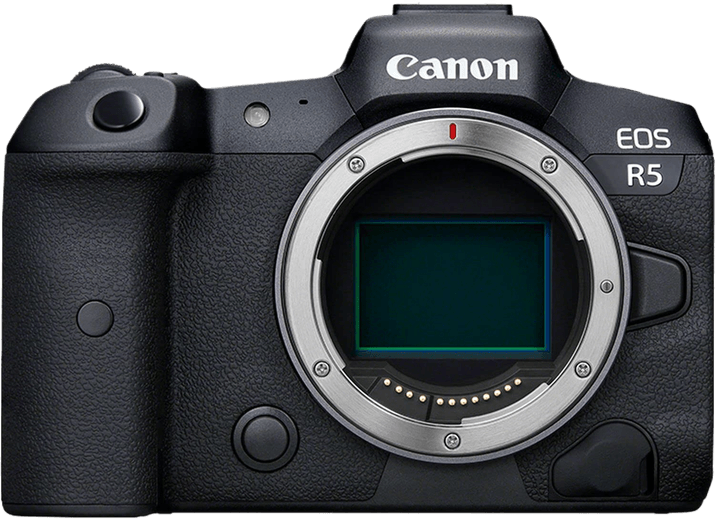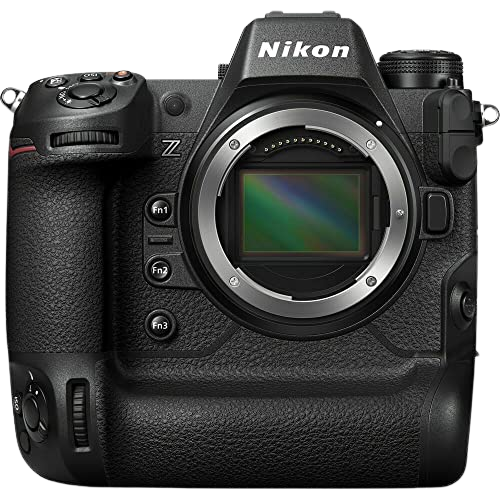Canon EOS R5 vs Nikon Z9 Comparison
Canon EOS R5

Nikon Z9

The Nikon Z9 edges out the Canon EOS R5 by just one point, scoring 87/100 compared to the R5’s 86/100. Both cameras are mirrorless and were released within a year of each other, with the R5 in 2020 and the Z9 in 2021. They share similarities in size, with the R5 measuring 138 x 98 x 88mm and the Z9 at 149 x 150 x 91mm. However, the Nikon Z9 is significantly heavier at 1340g, while the Canon R5 weighs just 680g.
The Canon EOS R5 has the advantage of a lower launch price, costing $4499 compared to the Nikon Z9’s $5500. This makes the R5 a more budget-friendly option for those seeking a high-quality camera. On the other hand, the Nikon Z9’s higher score suggests superior overall performance, despite its higher price and weight.
Ultimately, the choice between these two cameras depends on the user’s priorities. The Canon EOS R5 offers a more affordable and lightweight option, while the Nikon Z9 delivers marginally better performance at a higher cost and weight.
Canon EOS R5 vs Nikon Z9 Overview and Optics
The Canon EOS R5 and Nikon Z9 both have an optics score of 88/100, indicating a tie in this category. These cameras share several common specifications, including a CMOS sensor, full-frame sensor size, and built-in image stabilization. Both cameras also have their respective lens mounts, with the Canon EOS R5 featuring the Canon RF mount and the Nikon Z9 featuring the Nikon Z mount.
The Canon EOS R5 has 45 megapixels, a shooting speed of 20 frames per second, and a DXOMARK sensor score of 95. Its processor is the Digic X. In comparison, the Nikon Z9 has slightly better specs, with 46 megapixels, a faster shooting speed of 30 frames per second, and a higher DXOMARK sensor score of 98. The Nikon Z9 uses the Expeed 7 processor.
Despite the Nikon Z9 having marginally better specifications, the Canon EOS R5 still holds its ground, particularly with its lens mount, which allows access to a wide range of Canon RF lenses. This offers photographers versatility and flexibility in choosing lenses to suit various shooting situations.
On the other hand, the Nikon Z9’s faster shooting speed and higher DXOMARK sensor score make it a strong contender, especially for action and sports photography. Its Nikon Z lens mount also provides compatibility with a growing selection of high-quality Nikon lenses.
Both cameras excel in their respective areas, with the Canon EOS R5 offering versatility through its lens mount and the Nikon Z9 providing superior performance in terms of speed and sensor quality. Ultimately, the choice between these two cameras will depend on the specific needs and preferences of the photographer.
Canon EOS R5 vs Nikon Z9 Video Performance
The Canon EOS R5 and the Nikon Z9 both excel in their video capabilities, with each camera achieving a perfect video score of 100/100. This indicates that both cameras are top performers in this category. However, there are some differences and similarities between these two models that are worth examining.
Both cameras boast impressive 8K video resolution, allowing for extremely high-quality footage. Additionally, they both offer a maximum video frame rate of 120fps and have built-in time-lapse functionality. These shared features demonstrate that both cameras are well-suited for various video projects and situations.
The Canon EOS R5 has a slight edge over the Nikon Z9 in terms of maximum video dimensions, offering 8192 x 4320 pixels compared to the Nikon Z9’s 7680 x 4320 pixels. This difference results in a marginally higher level of detail and clarity in the captured footage. This advantage may be significant for users who prioritize video quality and require the highest possible resolution for their projects.
Conversely, the Nikon Z9 does not outperform the Canon EOS R5 in any specific video-related aspect. Both cameras are evenly matched in their video capabilities, with the exception of the Canon EOS R5’s slightly superior video dimensions.
Taking these factors into account, it is evident that the Canon EOS R5 and Nikon Z9 are both exceptional cameras for video recording. The Canon EOS R5 holds a minor advantage in video dimensions, but this may not be significant enough to sway users who are already partial to the Nikon brand. Ultimately, both cameras provide outstanding video performance and would be suitable choices for any videographer.
Canon EOS R5 vs Nikon Z9 Features and Benefits
The Canon EOS R5 and the Nikon Z9 both have a feature score of 87/100, making them equally competitive in terms of their capabilities. They share several common features, such as a 3.2-inch screen size, touchscreen functionality, flip screen, WIFI, and Bluetooth connectivity.
The Canon EOS R5 has a slightly higher screen resolution of 2,100,000 dots compared to the Nikon Z9’s 2,088,960 dots. This difference in resolution provides the R5 users with a marginally better display quality for image preview and menu navigation.
On the other hand, the Nikon Z9 has a GPS feature, which the Canon EOS R5 lacks. This GPS functionality allows Z9 users to geotag their photos, making it easier to organize and locate images based on the shooting location. This advantage can be particularly useful for travel and landscape photographers who need to keep track of various shooting spots.
Despite the minor differences in screen resolution and GPS functionality, both cameras offer a similar feature set that caters to the needs of professional photographers. The Canon EOS R5’s higher screen resolution may appeal to those who prioritize display quality, while the Nikon Z9’s GPS feature may be more attractive to photographers who require geotagging capabilities.
In the end, the choice between these two cameras comes down to personal preferences and specific requirements. Both the Canon EOS R5 and the Nikon Z9 are high-quality cameras with a wide range of features, making them suitable for various photography styles and professional needs.
Canon EOS R5 vs Nikon Z9 Storage and Battery
The Nikon Z9 outperforms the Canon EOS R5 in storage and battery, scoring 79/100 compared to the R5’s 68/100. Both cameras have two memory card slots and accept SD/SDHC/SDXC (UHS-II compatible) and CFexpress cards. They also feature USB charging.
The Z9’s advantage lies in its extended battery life, providing 740 shots compared to the R5’s 320 shots. This is due to the Nikon’s EN-EL18d battery type, which is more powerful than the Canon’s LP-E6NH. Additionally, the Z9 is compatible with XQD memory cards, giving users more storage options.
While the Canon EOS R5 falls short in battery life, it still offers reliable storage and charging capabilities. Both cameras are suitable for various photography needs, but the Nikon Z9’s longer battery life and extra memory card compatibility make it a better choice for extended shooting sessions and versatile storage requirements.
Canon EOS R5 vs Nikon Z9 Alternatives
Still not sure which camera is best for you? Check out some more popular camera comparisons for inspiration:
